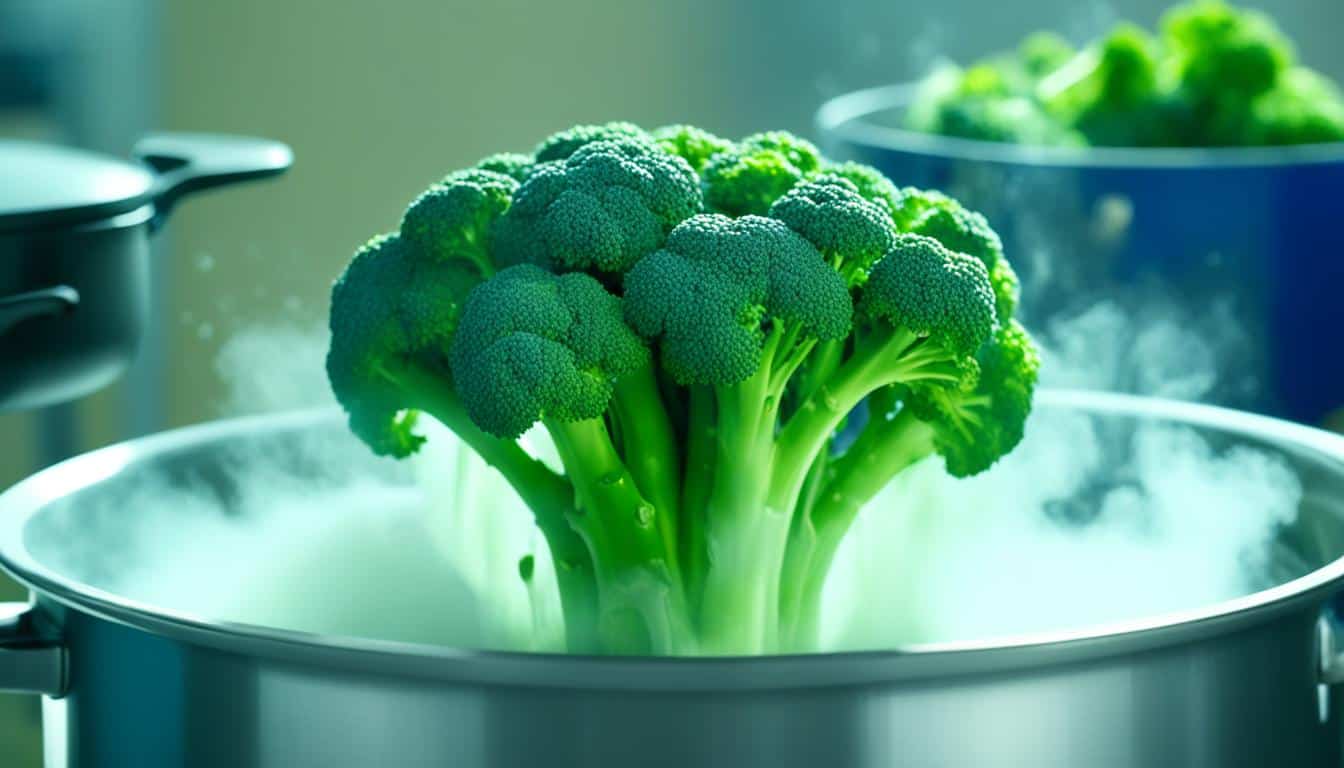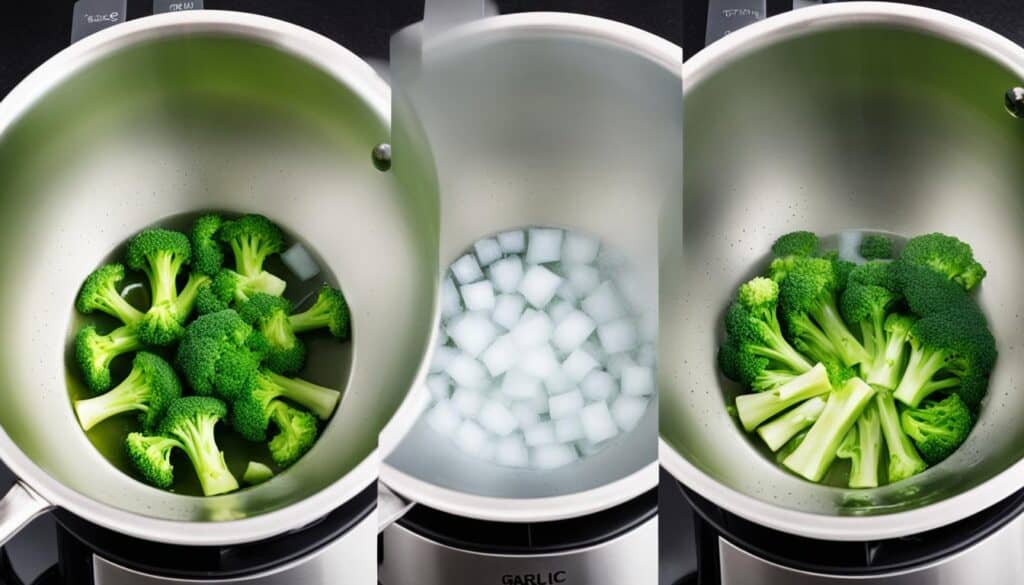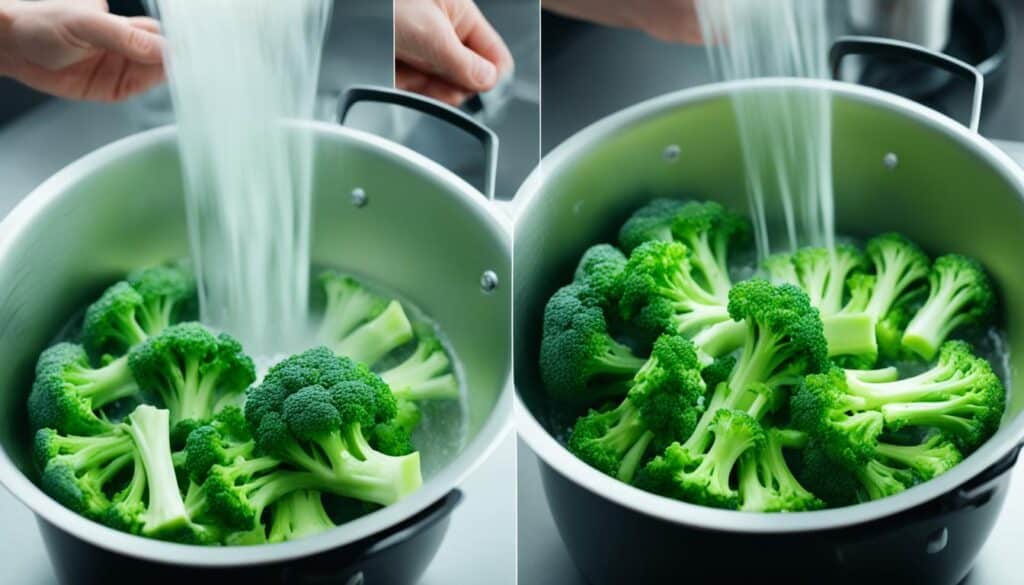Did you know that blanching broccoli can transform its taste and appearance, making it more palatable and visually appealing? This simple cooking technique is a game-changer when it comes to preparing broccoli for various dishes. Whether you want to include blanched broccoli in stir-fries, salads, or freeze it for later use, mastering the art of blanching can take your culinary skills to the next level.
So, if you’re curious to learn the secrets of blanching broccoli and how it can elevate your cooking, you’ve come to the right place. In this article, I will share essential tips and step-by-step instructions to help you blanch broccoli to perfection. From understanding the benefits of blanching to exploring different ways to use blanched broccoli, get ready to unlock new dimensions of flavor and texture in your dishes.
Key Takeaways:
- Blanching broccoli removes its raw, bitter taste while preserving its vibrant green color.
- The blanching process partially cooks the vegetable, achieving a tender-crisp texture.
- Blanched broccoli can be used in stir-fries, salads, and frozen for future use.
- Proper cutting and flash freezing techniques enhance the quality and convenience of blanched broccoli.
- Mastering blanching broccoli opens up a world of versatile and nutritious recipes.
Why Blanch Broccoli?
Blanching broccoli offers several benefits. First, it helps to tame the raw, bitter taste of the vegetable, making it more palatable. Second, blanching preserves the bright green color of the broccoli, enhancing its visual appeal. Lastly, blanching broccoli helps to partially cook the vegetable, achieving a tender-crisp texture that can be easily incorporated into various recipes.
When you blanch broccoli, you create a culinary transformation. The process not only improves the taste of the vegetable but also enhances its overall appearance. By blanching, you can enjoy broccoli that is vibrant, flavorful, and versatile in your favorite dishes. The blanched broccoli becomes a perfect canvas for stir-fries, salads, and a wide range of other culinary creations.
“Blanching fundamentally changes the broccoli, turning it into a more delightful and milder version of itself.” – Culinary Expert
Blanching broccoli benefits not only your taste buds but also your health. Broccoli is brimming with essential nutrients like vitamins C and K, fiber, and antioxidants. By blanching and partially cooking the broccoli, you retain these valuable nutrients while achieving a desirable texture. Whether used in a quick stir-fry or tossed in a refreshing salad, blanched broccoli adds a nutritional punch to your meals.
H3: The Palatability Factor
One of the primary reasons to blanch broccoli is to improve its flavor. Raw broccoli can have a slightly bitter and fibrous taste that some find unpleasant. Blanching helps to break down the enzymes responsible for the bitterness, resulting in a milder and more enjoyable flavor. By blanching broccoli, you can transform it into a delicious and versatile ingredient that can be used in a variety of recipes.
- By blanching, you can enjoy the natural sweetness of the broccoli without the overpowering bitterness commonly associated with the raw vegetable.
- The milder taste of blanched broccoli makes it an ideal addition to salads, stir-fries, pasta dishes, and more, allowing it to blend seamlessly with other ingredients.
- The improved flavor of blanched broccoli appeals to both adults and children, making it easier to incorporate this nutrient-rich vegetable into your everyday meals.
H3: The Visual Appeal
Blanching broccoli not only enhances its taste but also elevates its visual appeal. The blanching process helps to preserve the vibrant green color of the broccoli, luring you in with its fresh and inviting appearance. By blanching, you can experience the joy of serving and indulging in beautifully vivid broccoli that adds a pop of color to any dish.
When blanched, broccoli becomes a showstopper in salads, vegetable platters, and other culinary creations. Its bright green hue adds visual interest and makes the dish more visually appealing. Aesthetically pleasing food is not only more enjoyable to eat but also more enticing to try, encouraging a greater intake of nutritious vegetables.
H3: Versatile and Tender-Crisp Texture
Blanching broccoli provides you with a vegetable that is not only visually appealing and flavorful but also has a tender-crisp texture. The blanching process partially cooks the broccoli, allowing it to retain a pleasant crunch while being softer and more palatable than raw broccoli.
The tender-crisp texture of blanched broccoli makes it a versatile ingredient that can be used in a variety of dishes. It can be easily added to stir-fries, pasta dishes, casseroles, or even enjoyed on its own as a nutritious snack. The balanced texture of blanched broccoli ensures a delightful eating experience and enhances the overall enjoyment of your meals.
How to Blanch Broccoli: Step-by-Step Guide
To blanch broccoli, follow these simple steps:
- Start by bringing a pot of salted water to a rapid boil.
- While the water is heating, prepare an ice bath by filling a large bowl with cold water and ice.
- Cut the broccoli florets into similar-sized pieces for even cooking.
- Carefully lower the florets into the boiling water and cook for 2 to 3 minutes, until they turn bright green and become slightly tender.
- Remove the broccoli using a slotted spoon and immediately transfer it to the ice bath to stop the cooking process.
- Once the broccoli is completely cooled, drain and pat it dry before using or storing.
Blanching broccoli is a crucial step in achieving the perfect texture and color for your dishes. The brief cooking time helps to soften the broccoli slightly while preserving its vibrant green color and natural crunch. By following this step-by-step guide, you can quickly and easily blanch broccoli for various recipes.
Blanching not only improves the taste and appearance of broccoli but also makes it more versatile for different preparations. Whether you choose to use blanched broccoli in stir-fries, pasta salads, or as a healthy side dish, this cooking technique elevates the flavor and texture of this nutritious vegetable.
Tips for Blanching Broccoli
Blanching broccoli is a simple and effective way to enhance its taste, texture, and color. To ensure successful broccoli blanching, here are some helpful tips:
- Cut the broccoli florets into uniform sizes for even cooking. This ensures that all the florets cook at the same rate and avoid overcooking some pieces while undercooking others.
- Choose fresh and firm broccoli with a bright green color. Fresh broccoli ensures better flavor and texture after blanching.
- Use an ice bath to quickly cool the blanched broccoli and maintain its vibrant green color. Placing the blanched broccoli in an ice bath stops the cooking process and helps retain its original color.
- Pat the broccoli dry after blanching to remove excess moisture and prevent sogginess. Excess moisture can affect the texture and make the broccoli watery when added to dishes.
- Blanch a larger quantity of broccoli and freeze the excess for future use. Blanching and freezing broccoli is a great way to preserve its freshness, allowing you to enjoy it even when it’s out of season.
By following these tips, you can achieve perfectly blanched broccoli every time, ensuring that it retains its vibrant color, delicious flavor, and crisp texture. So, next time you have some broccoli on hand, give blanching a try!
Blanching Broccoli for Freezing
Blanching broccoli before freezing is an excellent way to preserve its freshness and quality. When you blanch broccoli, it helps to maintain its vibrant color, crisp texture, and natural flavor even after being frozen. Here’s how you can blanch broccoli for freezing:
- Prepare the Broccoli: Start by washing the broccoli thoroughly under cold water to remove any dirt or debris. Trim off the tough stems and cut the florets into bite-sized pieces.
- Blanching: Bring a pot of salted water to a boil and carefully drop the broccoli florets into the boiling water. Blanch them for 2-3 minutes until they turn bright green and slightly tender.
- Cooling: Using a slotted spoon, transfer the blanched broccoli immediately into a bowl filled with ice water. This stops the cooking process and cools down the broccoli quickly.
- Drain and Dry: Once the broccoli is completely cooled, remove it from the ice water and drain well. Pat the blanched broccoli dry with a clean kitchen towel to remove any excess moisture.
- Freezing: Transfer the blanched and dried broccoli to freezer-safe containers or bags. Squeeze out as much air as possible from the containers to prevent freezer burn. Label the containers with the date and name of the contents before placing them in the freezer.
Blanching broccoli for freezing helps to maintain its color, texture, and flavor throughout the freezing process. Now you can enjoy the benefits of having blanched broccoli readily available for your favorite dishes all year round!
Blanching Broccoli for Stir-Fry
If you plan to use blanched broccoli in a stir-fry, the blanching process helps to partially cook the vegetable and reduce the overall cooking time. After blanching, drain the broccoli and pat it dry.
Heat a pan or wok with oil, then add the blanched broccoli along with other stir-fry ingredients. Stir-fry until the broccoli is heated through and crisp-tender. Blanched broccoli adds a vibrant and tender element to stir-fry dishes.
Tips for Using Blanched Broccoli in Stir-Fry:
- Ensure the pan or wok is hot before adding the blanched broccoli.
- Consider adding garlic, ginger, or other aromatic ingredients to enhance the flavors.
- Add a splash of soy sauce or stir-fry sauce for a savory touch.
- Stir-fry the broccoli for a few minutes until it reaches your desired level of crispness.
- Combine the blanched broccoli with other vegetables, protein, and sauce for a complete stir-fry meal.
Blanching Broccoli for Salad
Blanching broccoli for salads offers a delightful contrast of textures and flavors. After blanching and cooling the broccoli, drain and pat it dry. Cut the blanched florets into bite-sized pieces and add them to your salad. Blanched broccoli retains its bright green color and adds a tender-crisp element to salads. It pairs well with other vegetables, dressings, and toppings for a refreshing and nutritious salad.
Blanching broccoli enhances its versatility in salad recipes. Whether you’re creating a simple garden salad or a more elaborate grain-based salad, blanched broccoli adds both visual appeal and a pleasing crunch. The quick blanching process removes the raw, bitter taste of the vegetable while preserving its vibrant color.
Benefits of Blanching Broccoli for Salad Retains bright green color Offers a tender-crisp texture Enhances flavor with a milder taste Combines well with other salad ingredients Blanched broccoli is a versatile addition to a wide range of salads. Its vibrant color and crispy texture make it a fantastic complement to leafy greens, tomatoes, cucumbers, and other vegetables. Additionally, it pairs beautifully with various dressings, such as vinaigrettes or creamy options like ranch or Caesar.
Experiment with different salad combinations to create a personalized dish that suits your taste buds. Whether you prefer a light and refreshing salad or a heartier option packed with protein and grains, blanched broccoli will add a nutritious and flavorful element that elevates your salad experience.
Blanching broccoli for salads is a simple and effective technique that takes your culinary creations to the next level. With its vibrant color, crisp texture, and milder taste, blanched broccoli is sure to become a favorite ingredient in your salad repertoire.
How to Cut Broccoli
Properly cutting broccoli is essential for even cooking and presentation. Here’s a step-by-step guide on how to cut broccoli:
- Start by trimming about an inch off the bottom of the broccoli trunk to remove any woody or fibrous parts.
- Remove any tough leaves that may be attached to the trunk.
- If the outer skin of the trunk appears fibrous, gently peel it away using a vegetable peeler to improve the broccoli’s texture.
- Cut the broccoli head into florets of similar size to ensure even cooking.
- If desired, you can also cut the trunk into smaller pieces or save them for other recipes.
Note: Cutting broccoli into similar-sized florets helps to ensure that they cook evenly. This is important for achieving a consistent texture in your dishes.
Now that you know how to cut broccoli, you can prepare it easily for your favorite recipes. Whether you’re blanching, stir-frying, or using broccoli in salads, proper cutting techniques will enhance the cooking process and presentation.
Tips for Cutting Broccoli
If you’re looking for some additional tips to make the broccoli-cutting process even easier, here are a few suggestions:
- Use a sharp knife to make clean cuts and avoid crushing the broccoli.
- Keep your fingers away from the blade and use a cutting board to avoid accidents.
- If the florets are too large, you can further divide them into smaller, bite-sized pieces.
- Save the broccoli stalks to use in soups, stir-fries, or as a crunchy snack.
Flash Freezing Broccoli
When it comes to preserving the quality and flavor of your freshly blanched broccoli, flash freezing is the way to go. This rapid freezing technique ensures that each individual piece of broccoli maintains its integrity and prevents any unpleasant sticking together.
After blanching and allowing the broccoli to cool, it’s time to move on to the flash freezing process. Spread the blanched florets or pieces evenly on a baking sheet, taking care to make sure they are not touching each other. This will prevent the broccoli from clumping together during the freezing process.
Once the broccoli is arranged on the baking sheet, it’s time to place it in the freezer. Let the baking sheet sit in the freezer for a couple of hours, allowing the broccoli to freeze completely.
After the flash freezing is complete, it’s time to transfer the frozen broccoli to airtight containers or freezer bags for longer storage. This step is crucial in preventing freezer burn and maintaining the quality of the broccoli.
And there you have it – your flash frozen broccoli is ready to be enjoyed at any time. Whether you’re using it in soups, stir-fries, or simply as a side dish, flash freezing helps to retain the nutrients and freshness of the broccoli while making it easier to portion out as needed.
So, the next time you find yourself with an abundance of blanched broccoli, remember the flash freezing technique for optimal freshness and convenience.
Flash Freezing Broccoli – Summary:
Benefits of Flash Freezing Broccoli Steps for Flash Freezing Broccoli
- Preserves quality and flavor
- Prevents sticking together
- Maintains nutrients
- Spread blanched broccoli on a baking sheet
- Ensure pieces are not touching
- Freeze the baking sheet for a couple of hours
- Transfer frozen broccoli to airtight containers or freezer bags
Conclusion
Blanching broccoli is a simple and effective cooking method that enhances the taste, color, and texture of the vegetable. By following the step-by-step guide and utilizing the tips provided, you can achieve perfectly blanched broccoli every time. Whether you use blanched broccoli in stir-fries, salads, or freeze it for later use, this cooking technique adds versatility and nutritional value to your dishes.
Blanched broccoli retains its vibrant green color and crispness, making it visually appealing and enjoyable to eat. The blanching process removes the raw, bitter taste of broccoli, making it more palatable for even the pickiest eaters. It also partially cooks the vegetable, achieving a tender-crisp texture that adds depth to dishes.
Don’t hesitate to experiment with blanched broccoli in various recipes. Add it to stir-fries for a burst of color, toss it into salads for a refreshing bite, or freeze it to have on hand for convenient meal prep. Regardless of how you use it, blanched broccoli brings versatility, nutrition, and a vibrant touch to your culinary creations. Enjoy the delightful results of blanching broccoli and elevate your cooking to new heights!
FAQ
What are the benefits of blanching broccoli?
Blanching broccoli helps to tame the raw, bitter taste of the vegetable, preserve its bright green color, and achieve a tender-crisp texture.How do I blanch broccoli?
To blanch broccoli, bring a pot of salted water to a boil, add the broccoli florets, and cook for 2 to 3 minutes until they turn bright green and become slightly tender. Then, transfer the broccoli to an ice bath to cool and stop the cooking process.What are some tips for successful broccoli blanching?
Some helpful tips include cutting the broccoli into uniform sizes, choosing fresh and firm broccoli, using an ice bath to cool the blanched broccoli, patting it dry after blanching, and freezing any excess for future use.Can I blanch broccoli before freezing?
Yes, blanching broccoli before freezing is recommended to preserve its freshness and quality. After blanching, cool the broccoli completely, drain it, pat it dry, and store it in freezer-safe containers or bags.How can I blanch broccoli for stir-fry?
After blanching and cooling the broccoli, drain and pat it dry. Heat a pan or wok with oil, add the blanched broccoli along with other stir-fry ingredients, and cook until the broccoli is heated through and crisp-tender.How can I blanch broccoli for salads?
Once the blanched broccoli is cool, drain, and pat it dry. Cut the florets into bite-sized pieces and add them to your salad. The blanched broccoli retains its vibrant green color and adds a tender-crisp element to salads.How do I properly cut broccoli?
Start by trimming the bottom of the broccoli trunk and removing any tough leaves. Cut the broccoli into florets and ensure similar-sized pieces for even cooking. The trunk can also be cut into smaller pieces or used in various dishes.What is flash freezing and how can I do it with broccoli?
Flash freezing is a technique where you rapidly freeze individual pieces of broccoli to maintain their quality and prevent them from sticking together. After blanching and cooling the broccoli, spread the individual florets or pieces onto a baking sheet, freeze them for a couple of hours, and then transfer them to airtight containers or freezer bags for longer storage.










Leave a Reply